Discovering Optimal Kite Designs for Performance
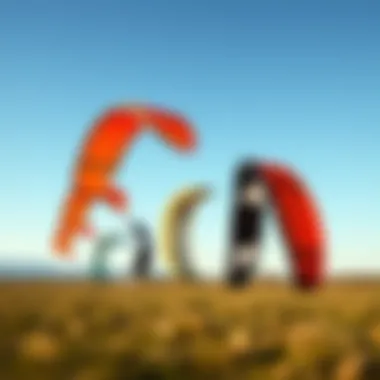
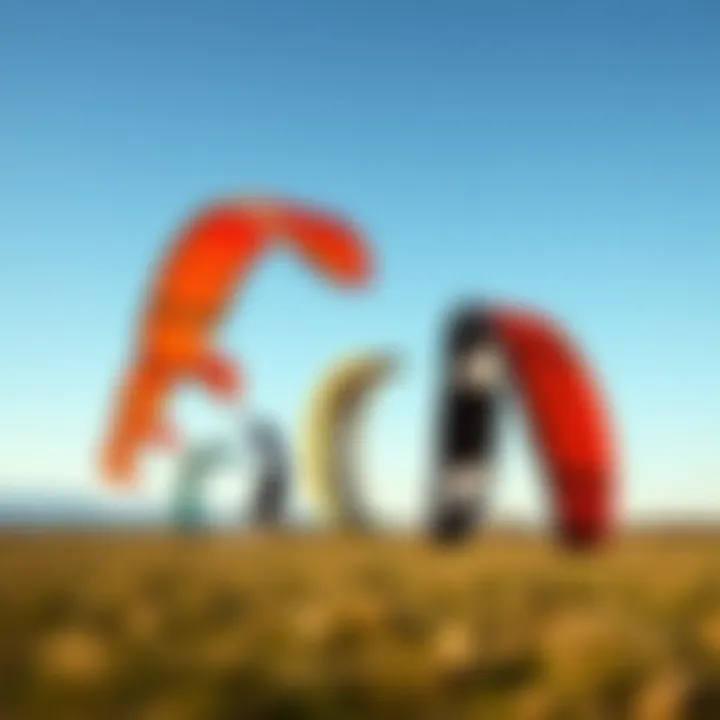
Intro
Kiteboarding is not just a sport; it's a dance with the wind. The kite plays a crucial role in this choreography. When analyzing kite designs, one must consider a multitude of factors—shape, size, and purpose, to name a few. Each design offers a unique experience, tailoring to the needs of different riders, whether they are cutting through the waves or soaring into the sky.
Understanding the nuances of kite designs is what separates a beginner from a seasoned kiteboarder. Not all kites are created equal. Some are meant for flat water while others excel in the surf. By choosing the right design, riders not only enhance their performance but also elevate their overall experience on the water. This guide aims to shed light on these intricacies, helping enthusiasts make informed decisions while diving into the exciting world of kiteboarding.
In the following sections, we will examine everything from the latest gear reviews to essential maintenance routines, and from beginner techniques to advanced maneuvers. This comprehensive narrative aims to enrich your understanding of kite designs, celebrating the innovations pushing the sport forward while ensuring you have the tools to maximize your kiteboarding adventures at any skill level.
Preface to Kite Designs
Kite designs serve as the foundation of any successful kiteboarding venture. Understanding the various elements involved in kite design can mean the difference between a pleasurable ride and a frantic attempt to keep the kite aloft. In this section, we will delve into the essentials of kite designs, highlighting their significance and benefits to riders of all skill levels.
Definition of Kite Designs
Kite designs encompass the blend of shapes, materials, and configurations used in crafting kites. They are not just pieces of colorful fabric flown high in the sky; they are intricate structures designed to harness wind energy efficiently.
When you think about it, a kite is essentially a sail, relying on airflow to create lift. A well-designed kite captures the wind perfectly, allowing riders to perform tricks, slice through waves, or simply enjoy a serene float in the air. The components that make up a kite include the canopy, frame, bridle, and lines. Each of these plays a critical role in how the kite behaves under various conditions.
Importance of Kite Design in Performance
The significance of kite design in performance cannot be understated. A kite's attributes directly affect its stability, maneuverability, and overall rider experience. Here's why thoughtful design is crucial:
- Stability: Kites designed with the correct balance help maintain flight without excessive control adjustments. This is a pretty important factor for beginners who might struggle with control.
- Lift: The geometry influences how quickly a kite can rise and how high it can fly. Designers invest time in creating shapes that optimize lift, catering to all winds, whether a gentle breeze or a strong gust.
- Maneuverability: Advanced riders crave kites that respond quickly to inputs, allowing for sharp turns or quick dives. In contrast, leisure riders may prefer a more stable kite offering a relaxed ride.
- Durability: The materials chosen impact not only performance but lifespan too. Kites need to withstand the harshness of the environment, from sand to saltwater, so durability is a vital component.
In summation, kite designs are not just about aesthetics; they influence everything from riding style to safety. Understanding these intricacies sets the stage for enhancing your kiteboarding journey, leading to better experiences and skills on the water.
"Getting to know your kite design intimately is like building a relationship; the better you understand it, the more you’ll trust it."
As we move forward into the diverse types of kites, we will see how each design caters to specific needs and preferences, equipping riders to make informed choices that align with their ambitions on the water.
Types of Kites
Understanding the different types of kites is crucial for anyone looking to enhance their kiteboarding experience. Each kite type offers distinct characteristics and functionalities tailored for specific conditions and performance. Selecting the right kite type influences not just your riding style but also your learning curve and overall enjoyment on the water.
Fixed-Leading Edge Kites
Fixed-leading edge kites are known for their stability and ease of control, making them a popular choice among both beginners and seasoned riders. These kites maintain a consistent shape thanks to a rigid leading edge, enabling them to perform well in varied wind conditions. They are versatile tools that can suit a wide range of skills and preferences.
Key benefits of fixed-leading edge kites include:
- Stability: They hold their shape well against the wind, allowing for smoother rides.
- User-Friendly: Their predictable flying pattern helps newcomers build confidence.
- Versatile Performance: Suitable for various styles of riding, from freestyle to wave riding.
However, they do require a bit more effort to relaunch in certain conditions, especially when the wind is light. That said, once you get a hang of it, they are fantastic for pushing your limits.
Inflatable Kites
Inflatable kites are a game-changer in the kiteboarding world, combining lightweight construction with impressive performance. These kites rely on air-filled bladders that provide lift while offering unique advantages like easy transport and storage. Inflatable kites tend to perform excellently in various wind conditions, making them a favorite for riders at all levels.
Some notable features include:
- Portability: Deflating and packing them down makes transport a breeze, perfect for those who travel.
- Durability: Made from high-quality materials that tolerate wear and tear better than traditional kites.
- Ease of Relaunch: The buoyancy from the air bladders aids in effortless relaunching from the water.
Despite their advantages, it's worth mentioning that inflatable kites can be a bit pricier than other options and may require more maintenance due to the delicate bladders.
Foil Kites
Foil kites feature a unique design characterized by an open cell structure, which makes them incredibly lightweight and efficient in the air. They are particularly well-suited for competitive riders and those seeking maximum performance in urban conditions. Because of their design, foil kites tend to excel in light winds, offering a distinct edge over other types in specific settings.
Key characteristics:
- Light Wind Capability: Known for their ability to catch even the gentlest of breezes.
- Efficiency: They have faster turning rates, making them favorable for tricks and maneuvers.
- Minimalist Design: Their lack of built-in bladders means less weight and easier handling when flying.
However, foil kites can be tricky for beginners due to their sensitivity to wind changes. Riders often need a solid understanding of wind dynamics to handle them effectively.
Overall, the type of kite you choose greatly affects your kiteboarding experience. Whether you're drawn to the stability of fixed-leading edge models, the convenience of inflatable kites, or the high-performance nature of foil kites, understanding their unique features will help you select a kite that aligns with your riding ambitions and conditions.
Functional Considerations
When it comes to kiteboarding, functional considerations are the bedrock of any successful experience. Choosing the right kite involves understanding various elements that can significantly impact performance. Each kite is designed with specific conditions and riding styles in mind. By focusing on functional aspects, enthusiasts can elevate their game and fully enjoy the thrill of kitesurfing.
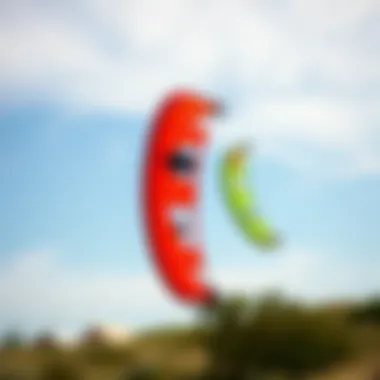
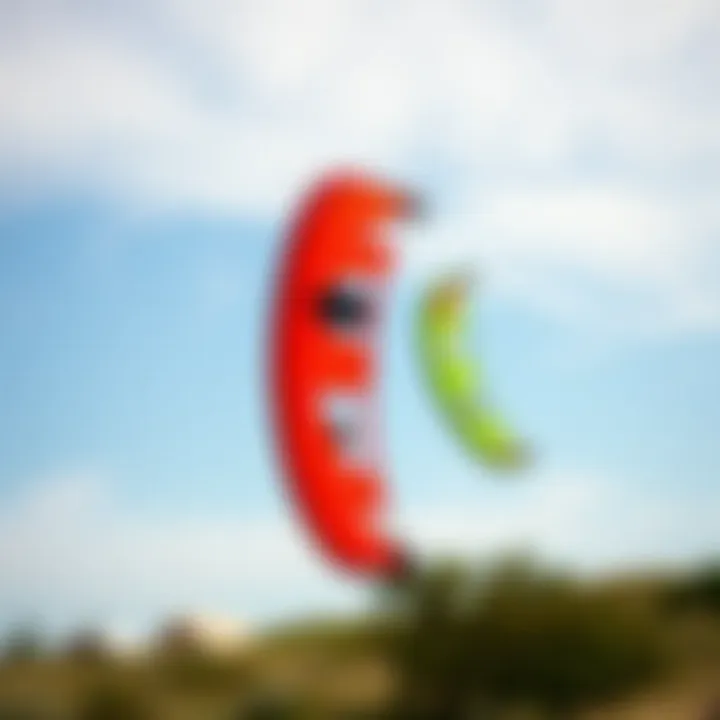
Wind Conditions and Their Impact
Wind is the lifeblood of kiteboarding. The intensity and direction of the wind can make or break a session. Kites are engineered to perform optimally in designated wind conditions. For instance, light winds might require a larger kite to harness enough lift, while strong winds demand smaller kites for better control and responsiveness.
Wind conditions are categorized into three types: light, moderate, and strong. Each of these conditions has its own kites that perform best. Beginners often benefit from larger kites when the winds are light, aiding in learning the basics without overwhelming speed. On the flip side, experienced kiteboarders typically opt for smaller kites in heavy winds to maintain agility and minimize the risk of accidents.
Factors such as local geographical features and altitude can also affect wind patterns. Understanding how these elements integrate with kite design can provide a significant advantage on the water.
"Selecting the right kite based on wind conditions can drastically change your performance and enjoyment in the sport."
Size Selection Based on Riding Style
Size selection goes hand in hand with riding style. The size of a kite directly influences how it interacts with wind, which ties back into control, speed, and power. Generally, larger kites provide more lift, making them suitable for freeride styles, while smaller kites facilitate tricks and speed in competitive riding.
Beginners should consider starting with a kite that offers a balance of power and ease of control. A medium-sized kite allows novices to transition smoothly into the sport without getting overpowered. Conversely, expert riders might lean towards smaller kites to aid in executing complex aerial maneuvers.
Here’s a simpler breakdown of size and riding style:
- Larger Kites (Over 12m)
- Medium Kites (8-12m)
- Smaller Kites (Under 8m)
- Ideal for light winds
- Better for freeride and beginners
- Great for varied winds
- Suitable for all-around riding
- Best for strong winds
- Preferable for tricks and racing
Balance Between Lift and Control
Achieving the perfect balance between lift and control is crucial for any kiteboarder. This balance dictates not just performance under various wind conditions, but also the safe execution of maneuvers. A kite that generates too much lift can make it difficult to maintain control, leading to dangerous situations.
The shape and design of the kite play a pivotal role in this equation. Kites with a flatter design often produce more lift; however, they may sacrifice some control as a trade-off. Alternatively, kites designed with a higher aspect ratio are generally more efficient at cutting through the wind, enabling refined control at higher speeds.
Here are key considerations:
- Lift
- Control
- Important for jumping and tricks
- Affected by kite shape and size
- Essential for navigation and stability
- Influenced by the kite’s aspect ratio and bridle design
Balancing between these two aspects requires experience and knowledge of various kite designs, along with extensive practice in different conditions. By addressing functional considerations critically, kiteboarders can truly harness the potential of their gear, enhancing both performance and enjoyment on the water.
Design Innovations
Design innovations in kite development are not just fancy trinkets; they’re game changers. With continual advances in materials and aerodynamics, today's kites are equipped to tackle a variety of wind conditions and riding styles that would leave older models struggling at the shore. These innovations are significant because they enhance performance, improve durability, and cater to a wider audience of kiteboarders—from novices to seasoned pros.
Material Advancements
The evolution of materials has had a profound impact on kite design. Early kites often used heavy fabrics that limited maneuverability and performance. However, modern kites leverage lightweight and durable materials like ripstop nylon and polyester blends which not only reduce weight but also enhance resilience against punctures and tears.
These advancements make a kite more forgiving during landings and crashes, essential for learners honing their skills. It’s quite common to hear riders remarking how new kites feel almost weightless compared to their predecessors, leading to improved lift and responsiveness in the air. The development of double-coated fabrics also assists in repelling moisture. This feature ensures that riders stay dry and that the kite maintains its lightweight inertia, even in damp conditions.
Some notable advancements include:
- Composite materials: Combine substances for strength without added weight.
- UV-resistant coatings: Increase longevity by protecting against sun damage.
- Seamless construction: Reduce the number of weak points, improving overall integrity.
Aerodynamic Enhancements
As for aerodynamics, it’s all about how the kite interacts with the air. In recent years, designers have focused on optimizing the shape and profile of kites to maximize lift and control. Advanced computer simulations and wind-tunnel testing have enabled kite manufacturers to create models that glide seamlessly through the air, drastically changing how kites generate pull.
One prevalent innovation is the refined wing shapes. Modifications in curvature and width create kites that perform better across varying wind conditions without sacrificing stability. Specifically, delta-wing kites offer improved performance in gusty winds, providing a smoother ride and reducing the chances of stalling mid-air.
Another point of interest is the use of ventilated designs which allow for better air circulation over surfaces, reducing drag and enhancing speed. This can be crucial for advanced maneuvers and tricks that require quick adjustments. With these features in place, modern kites are designed with both thrill-seekers and casual riders in mind.
"The future of kite design isn’t just about going higher or faster; it’s about providing a tailored experience that matches the unique needs of each rider."
Through ongoing research and development, kite designers continue to push boundaries. In the end, these innovations are pivotal; they enrich the rider's experience significantly and make the kiteboarding journey more enjoyable, whether one’s just off the shore or soaring high in the skies. For those wanting to delve deeper, resources such as Wikipedia on Kites or Kiteboarding Forum provide excellent starting points for understanding these innovative designs.
Specialized Kite Designs


Specialized kite designs hold a pivotal role in the realm of kiteboarding, catering to distinct user needs and varying environmental conditions. While many kites offer general performance across different scenarios, specialized designs optimize specific attributes crucial for certain riding styles or skill levels. Understanding the nuances of these kites can transform a rider's experience, allowing for better control, increased safety, and enhanced enjoyment on the water or in the air.
Kites for Beginners
When it comes to learning how to kiteboard, having the right gear is essential for a smooth and enjoyable transition into the sport. Kites for beginners are typically designed with user-friendly characteristics that prioritize stability and ease of use. These kites often feature larger surface areas, which allows for greater lift at lower wind speeds, ensuring that newcomers can get off the ground without feeling overwhelmed.
Beginner kites usually come in a delta or bow shape since these designs provide excellent stability and easier relaunching if they go down. Moreover, many entry-level kites incorporate a soft leading edge and are often lighter, which reduces the risk of injury during the learning phase.
In addition, many manufacturers have started integrating safety features, like quick release systems, to provide peace of mind. This helps novices focus on mastering skills rather than worrying about potential risks associated with power kites.
A few considerations when selecting a kite for beginners include:
- Size: Opt for a kite that matches your weight and local wind conditions. A 9 to 12-meter kite is generally recommended.
- User Support: Many reputable brands provide instructional tools or community forums which can bolster the learning experience.
"Choosing the right kite is like picking the best sweet at the candy store—too many options can leave you dizzy, but the right one makes all the difference!"
High-Performance Kites for Experts
On the converse side of the spectrum, high-performance kites for experts are engineered to maximize agility and speed. These kites are often favored by seasoned athletes who seek to push the boundaries of what's possible on the water. They tend to have a more aerodynamic profile, enabling efficient airflow to enhance lift and responsiveness, vital for tricks and advanced maneuvers.
Expert kites are frequently crafted with robust materials that withstand intense conditions, allowing for clean performance even in challenging winds. The designs usually feature adjustable bridle systems that can quickly adapt to varying wind speeds and rider preferences. This adjustability is crucial for high-level competitions where every fraction of a second counts.
A few key elements that set high-performance kites apart include:
- Precision Handling: The feel and response of the kite to rider inputs are paramount, making a performance kite’s steering capabilities finely tuned.
- Durability: Many high-tier kites use advanced fabrics that stand up to wear and tear from rigorous sessions, making them a worthwhile investment.
- Enhanced Stability: Achieving balance during tricks or high-speed pursuits becomes easier with designs that emphasize stability at speed.
For enthusiasts looking to elevate their game, brands like North Kiteboarding, Cabrinha, and Liquid Force offer some top-tier options tailored for expert kiteboarders. Each of these companies infuses cutting-edge technology and years of engineering into their kite designs, refined over time through both user feedback and competition results.
Kite Design Comparisons
In the world of kiteboarding, the design of your kite isn't just a luxury but a fundamental aspect that can make or break your riding experience. When diving into kite design comparisons, it's crucial to understand how various designs impact performance, durability, and even pricing. Not all kites are created equal, and knowing the differences can help you make informed decisions, whether you're a beginner or a seasoned pro.
Performance Vs. Durability
When evaluating kites, performance and durability often stand out as the twin pillars of kite design. Riders tend to gravitate toward kites that promise peak performance, especially in various wind conditions. However, if a kite doesn't hold up under stress or wear, its high performance can quickly become irrelevant.
- Performance primarily refers to how well the kite flies, responds to steering inputs, and generates lift. A high-performance kite typically offers superior maneuverability and speed. For example, the Cabrinha Switchblade is admired for its versatility and responsiveness. Wind enthusiasts often find such kites to be thrilling in dynamic conditions.
- On the other hand, durability focuses on how long a kite will last under regular use. Kites made from sturdier materials like ripstop nylon tend to withstand wear and tear better than delicate options. For instance, brands like North with their Neo model emphasize robust construction, perfect for those who can't spare time for frequent replacements.
"A kite may soar high, but only the strong can endure the storm."
In a variety of environments, choosing between a high-performing kite that might need more frequent repairs and a durable but less agile option becomes vital. It's a balancing act that demands careful consideration of your personal riding style and the conditions you’ll face.
Affordability Vs. Quality
Another critical comparison lies between affordability and quality. While it may be tempting to opt for cheaper models, one must ask whether cutting costs now will lead to greater expenses later on.
When looking at kites, consider:
- Budget-friendly options might save cash upfront, but they could compromise essential features like build quality or aerodynamics. For example, some brands like Airush offer beginner-friendly kites that are easy on the pocket yet maintain a basic quality level.
- Quality kites, though pricier, often incorporate advanced technology and better materials. Companies like Slingshot develop kites with enhanced performance features, which can improve your skills and your longevity as a kiteboarder.
Here's a quick look at the trade-offs:
- More expensive kites might have:
- Cheaper kites might save money but often lack:
- Superior materials
- Enhanced safety features
- Better resale value
- Performance enhancements
- Longevity
- Adequate warranties
It's worth remembering that investing in quality often pays off in the long run. A kite that excels in performance and durability can yield years of enjoyment, while a budget kite may only frustrate.
Top Brands and Their Innovations
In the world of kites, the brands behind the designs wield significant influence over both performance and rider enjoyment. The right equipment can make the difference between a thrilling ride and a frustrating day on the water. Therefore, understanding the top kite brands and the innovations they bring to the table provides insight into selecting the equipment that aligns with your needs. These brands not only deliver quality products but often set the benchmarks for industry standards, revolutionizing design techniques and materials along the way.
Renowned Kite Manufacturers
Several brands emerge as frontrunners in the kite industry, known for their commitment to quality, performance, and cutting-edge technology.
- Naish: This brand has been around since the late 1970s and has consistently contributed innovative designs that elevate kiteboarding. Their focus is often on catering to diverse conditions, enabling riders to excel in everything from light winds to extreme performance scenarios.
- Cabrinha: Recognized for creating high-performance kites, Cabrinha emphasizes durability and versatility. Their kites are often engineered with features that cater to both novices and experienced riders, striking a balance that appeals to a wide audience.
- Ozone: Known for their commitment to sustainability and advanced design, Ozone has garnered a loyal following among kiteboarders. Their products frequently incorporate lightweight yet durable materials which are vital for those demanding high performance without compromising on environmental concerns.
- Slingshot: Their innovative approach has made Slingshot a household name among enthusiasts. The brand focuses on user-friendly designs that still pack a punch in terms of performance, appealing to riders of all skill levels.
Emerging Brands of Note
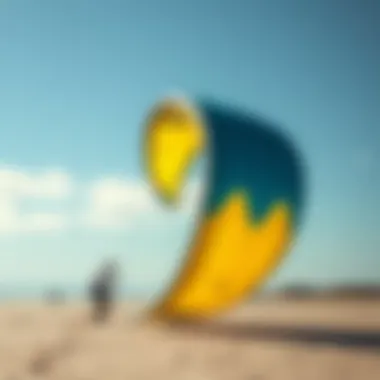
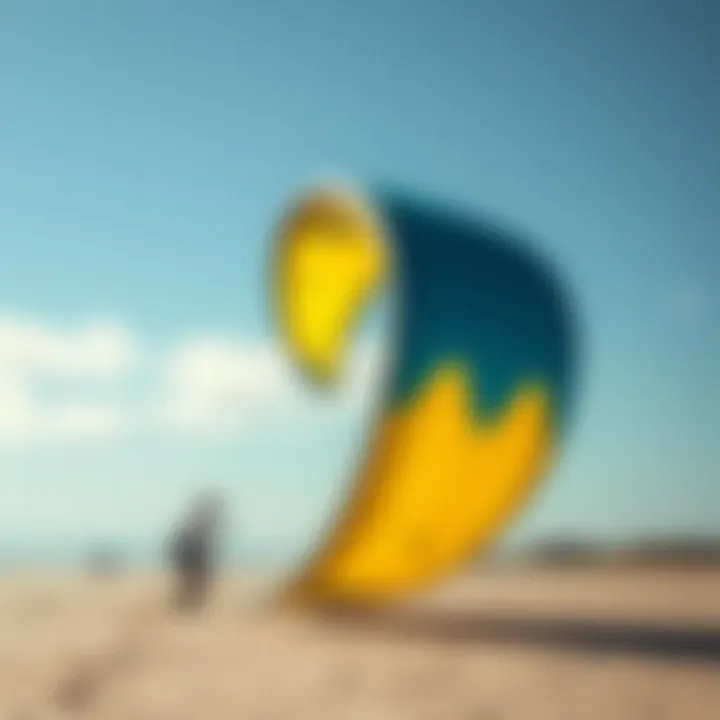
While established companies dominate the market, several up-and-coming brands have been making waves with fresh perspectives and innovative approaches.
- F-One: This French brand is gaining traction, known for its unique designs that blend style and functionality. Their drive toward creativity allows them to offer kites that not only perform well but also stand out visually.
- Airush: With a focus on performance and accessibility, Airush caters to riders who want the best of both worlds. Their recent products incorporate tech that provides enhanced ride stability and comfort, thanks to their rigorous testing and development processes.
"The kite industry thrives on innovation; both novices and seasoned riders can benefit from keeping an eye on emerging technologies and brands."
This succinct exploration aids enthusiasts in navigating their options, as understanding both established and rising brands can inform better purchasing decisions. As the landscape evolves, keeping pace with these changes is essential for anyone serious about kiteboarding.
User Experience with Kite Designs
User experience in kite designs plays a crucial role in shaping not just the rider's satisfaction, but also their performance and progression in the sport. Kites are not just equipment; they are tools that define how a rider interacts with the wind, waves, and their own capabilities. Thus, understanding how design elements influence performance can greatly enhance the enjoyment and effectiveness of kiteboarding.
In this section, we'll explore the varied experiences of riders using different kite designs and how these nuances affect their skill levels. Key elements involve user feedback, preferences, and the overarching impact of kite design on learning and enjoyment.
Case Studies and Rider Feedback
To grasp the diversity in user experiences, examining real-world case studies offers valuable insights. Riders come from different backgrounds, and their preferences often reflect their unique riding styles and conditions.
For instance, consider a beginner who chooses a samall, inflatable kite designed for stability. Many feedback reports highlight that this particular design reduces the learning curve, allowing novices to feel confident much earlier than with traditional styles. Riders frequently note the ease of relaunching these designs, an essential factor when tackling the learning phase.
Here are some key findings from various case studies:
- Ease of Control: Many riders mentioned that kites with higher stability features helped them maintain control better during windy conditions.
- Responsive Feedback: Some advanced riders prefer kites that respond quickly to inputs for tricks and maneuvers, indicating that a design that promotes rapid response increases their satisfaction.
- Comfort and Safety: Riders often prioritize designs that ensure safety features, particularly those that enable easy depowering in unstable winds. Feedback from various communities supports that comfort and safety scores significantly affect overall kite experience.
When these feedbacks are collated, they present a clear picture of how different kite specifications resonate with rider expectations. Reading through community forums such as KiteForum.com or feedback on various social media platforms often provides real gems about user experiences.
Influence of Design on Skill Development
The relationship between kite design and skill development cannot be overstated. As riders progress from beginners to seasoned pros, the kites they choose will greatly influence their technical abilities and confidence on the water. A well-designed kite tailored to a rider’s skill level will foster not only advancements in techniques but will also cultivate an enduring love for the sport.
For early learners, a kite that is forgiving and easy to handle builds foundational skills which are crucial. Riders immersed in an environment where they can practice control without excessive struggle often lead to skill acquisition more efficiently. For instance:
- Beginner Kites: These designs are typically easier to handle in various conditions, promoting learning through experience rather than frustration. Hearing stories from riders who made rapid progress using user-friendly designs is commonplace in rider communities.
- Intermediate to Advanced Kites: As skills improve, so does the rider’s tolerance for nuance in performance. Designs that offer precision control and enhanced feedback become essential for executing more complex trick techniques. Riders often share that refining turns or jumps with responsive gear builds confidence and enhances their skills more rapidly.
Interestingly, this journey of skill development correlates closely with tailored designs. The personalization that kites offer based on rider style invariably makes each session more enjoyable and rewarding.
In summation, user experience with kite designs plays a monumental role in the sport. From personal feedback to skill development trends, every aspect reinforces the significance of understanding how kite designs can shape one's journey in kiteboarding. Riders’ voices, particularly from forums and community gatherings, echo a similar sentiment: well-considered designs lead not just to better performance but also to happier, more confident riders.
Future Trends in Kite Design
The kiteboarding landscape is continually evolving. Keeping up with future trends in kite design is vital for riders wanting to leverage improvements that enhance their experience. It’s not just about catching the wind anymore; it’s about maximizing performance while being aware of the impact our sport has on the environment and how technology is reshaping the way we interact with our gear.
Sustainability in Kite Design
Sustainability has become a cornerstone of modern product design, and kiteboarding is no exception. Manufacturers are increasingly considering the environmental ramifications of the materials they choose and the processes they follow.
- Material Selection: From biodegradable resins to recycled fabrics, there has been a significant shift towards using eco-friendly materials. Brands are exploring options that don’t just minimize waste but also withstand the test of time, ensuring that kites remain functional for longer periods.
- Production Practices: Ethical production remains a hot topic. Companies are striving to reduce carbon footprints by utilizing energy-efficient manufacturing and striving for zero-waste factories. This move is not just about boosting their image; it’s a genuine effort to ensure the future of our planet, something all kite enthusiasts should care about.
"Choosing sustainability isn't just a trend; it's a commitment to the world we ride in, ensuring that our fun doesn't come at the cost of the environment."
- End-of-Life Considerations: Additionally, there's a growing awareness of how products impact the environment after their use. This has given rise to program initiatives that encourage recycling old kites or repurposing parts instead of leaving them to rust in storage.
Technological Integration
Integrating technology into kite design presents exciting possibilities that go beyond traditional concepts. The pace of tech development is relentless, and kiteboarding is reaping the benefits.
- Smart Kites: Imagine kites with integrated sensors that can communicate real-time performance data to your mobile device. This capability would offer insights into wind conditions, kite behavior, and even recommendations for optimal riding techniques. Such data-driven approaches not only enhance the riding experience but also help in skill progression for users of any level.
- Enhanced Aerodynamics: Advances in computational fluid dynamics are allowing designers to create kites with superior aerodynamic shapes. This results in improved speed, stability, and lift, giving users the upper hand in various wind conditions.
- Customization Options: Technological integrations allow riders to personalize their kites based on preference and conditions. For instance, adjustable aspects of the kite that can be changed on-the-fly provide a unique user experience tailored to individual needs.
By staying abreast of these trends, kiteboarders and manufacturers alike can innovate while respecting the environment, ultimately leading to a more sustainable and thrilling sport.
The End
As we draw the curtain on this intricate exploration of kite designs, it's essential to underscore the pivotal role each element plays in the overall kiteboarding experience. The nuances in kite design directly influence performance, rider comfort, and skill development.
Summary of Key Insights
In this guide, we navigated through a multitude of kite designs, from fixed-leading edge to inflatable kites, highlighting how each type accommodates specific wind conditions and rider preferences. We saw that kite design isn't just about aesthetics; it encompasses functionality, material choices, and aerodynamic features which can make or break a session on the water.
- Understanding the impact of wind: A kite’s ability to perform optimally under varying wind conditions is vital. The innovative designs crafted for diverse environments reveal a deep understanding of aerodynamics and rider capabilities.
- Importance of size: Selecting the right size based on your style can transform your riding experience. Not only does it affect lift, but also control in challenging conditions.
- The fine balance: The tug-of-war between lift and control often dictates performance outcomes. Understanding this balance equips riders to make informed choices that suit their unique styles.
Final Thoughts on Kite Design
The future of kite design is as promising as it is exciting. With rising trends in sustainability and the integration of advanced technology, kiteboarding is on the cusp of a new frontier. The emphasis on sustainable practices ties in with a broader societal shift toward a greener way of life, appealing to the environmentally-conscious rider.
As enthusiasts, instructors, and professionals, the knowledge garnered from this guide should empower your decisions. Whether you are selecting your first kite or upgrading to a high-performance model, understanding the intricacies of kite design is crucial.
"The best kite for you hinges on understanding your needs, the riding conditions, and how each design element interacts with these aspects."







